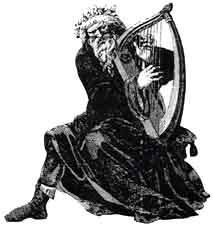The modern "pedal"
harp, in contrast, is only about 200 years old and is used mainly
for orchestral music. It has seven foot pedals in the rear, one
for each note of the scale, and they allow the musician to change
key quickly without interrupting the music. The sound of the pedal
harp is deep and the sound dies relatively quickly, whereas the
Celtic harp is brighter, with a longer ring off.
The
harper was held in great esteem in the life of the old clans.
There are records of payments being made to the clan harper in
the form of clothing, land, animals, and favors. The harper often
told the history of the clan in his music, and would sing about
the history by the fireside, noting important births and deaths,
victories and defeats through songs and tunes. It has been said
that the harper would lead the clan into battle, but it is more
likely that they inspired them to bravery during the battle through
the rallies the night before.
The Celtic harp is made of hardwoods such as cherry, walnut, and
maple. Occasionally other woods are used, particularly if the
wood has a supernatural significance. Oak was used for strength
and power, willow for sweetness and light. Silver, gems, and elaborate
carvings were used to decorate the harp and add to the magical
power of the music that was to come through the harp. More than
any other instrument, the harp is often given a formal name and
is referred to as if it had a soul. When one hears the wind blow
through the harp, the strings make it sound as if it were playing
by itself and one can understand why people were in awe of harps.
The
Celtic harp almost died out in the past 200 years as a result
of political suppression of the native cultures of Ireland and
Scotland. There has been a slow revival since the 1930s, which
has exploded since 1970. Many builders are now making harps relatively
inexpensively, and the harp is such an intimate instrument to
play that many people are attracted to it. Recordings and music
make it even more enticing, and the harp revival movement is thriving.








